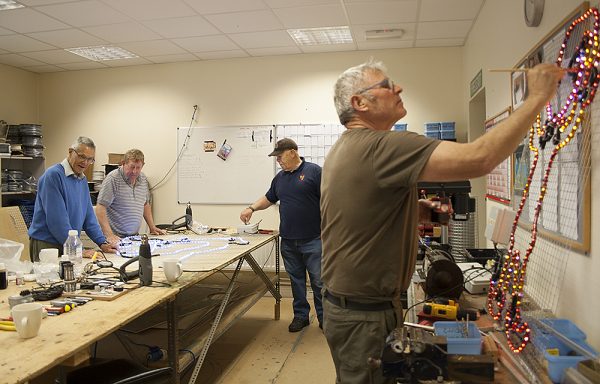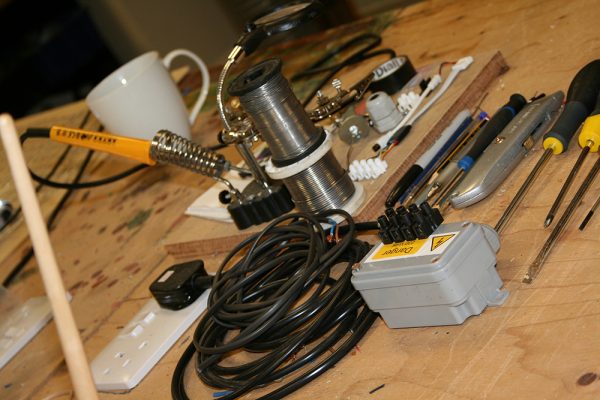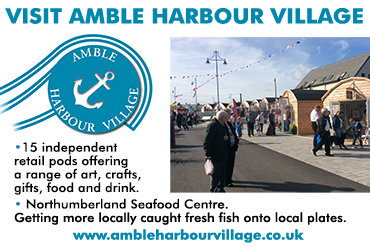The Story of Amble Christmas Lights
It’s hard to imagine Amble without a lighting display at Christmas. It’s something we’ve come to associate with towns with a sense of identity. Yet the displays in Amble as we know them have been around for less than thirty years and unlike many towns the lights in Amble have been almost completely created maintained and installed every year by a group of local volunteers. This is an attempt to set down the story of the lights and to record the individuals who helped to establish Amble Christmas Lights in the beginning. Obviously the original team has changed over the years. The current group of volunteers sadly doesn’t include any of the founding members, although several of the group have been involved for many years. Also, much of the information about the early years is missing or incomplete. If you have any information or recollections we would be very glad to hear from you.
Of course, Christmas lighting in Amble didn’t begin suddenly. The trend for people to put up lights all over their homes is a fairly recent one, but before shops sold cheap and reliable lights for outdoor use, lighting displays were mainly seen as something to be left to the professionals. Members of Amble Town Council had put up Christmas lights themselves for some years. These consisted of strings of lights attached to the buildings along Queen Street. However they did not span the street like the ones put up now. They were stored in the builders’ yard owned by Mrs Campbell-Smith, who had a shop on the street. Some of the builders’ ladders were used to put up the lights. When the council finally decided to end its formal involvement with the Christmas lights, a group of volunteers continued to be involved in organising the lighting display. These included Florence Angus, John Hedley, Robert Arckless and Bill Little, who ran the newsagents.
Soon there were moves to set up a more permanent body. So, on 29th May 1991 ‘The Amble Lights’ came into being at a meeting held at Dilston Terrace. Jimmy Thompson, who was a councillor, was elected chairman. Florence Angus was away on holiday at the time, but found out when she returned that she had volunteered to be both secretary and treasurer. She continued to work as a very effective secretary for the next two decades.
This was obviously a very energetic committee. Starting with no more than an intention, it raised £3637.80 by 18th November of the same year. The minutes of meetings held that year show that the money came from many sources: coffee mornings at the Catholic Church Hall; jumble sales in the Boys’ Club; bring and buy sales at The Wellwood. None of the organisations or businesses providing premises, resources and refreshments made any charge: this was a real community effort. There were also donations from local businesses and organisations and from many individuals. Money also came from a defunct fund, the Maritime Festival Fund.

The Christmas lights team
With the coffers filling ACL had to produce some Christmas lighting- and quickly. There were still the original lights which could be used, but something more was needed. For a start, new cabling was needed as a priority. Peter Proctor-Cannon, who worked at Acklington Prison in the vocational trades section, managed to source from there some obsolete but usable cable. There was still the need to improve the lighting displays themselves though. One of the first thoughts of committee members was to contact Blackpool Council to ask if they had any displays they no longer wanted. Amble at that stage couldn’t have seemed too much of a challenge to the Illuminations; nevertheless, the request was refused. As ever, local organisations came to the rescue. Amble High School pupils helped to create some early designs and prisoners at Acklington Prison set to work building wall boards. Peter Proctor-Cannon played a vital role in coordinating the work.
Things were starting to move. There was still a great deal for the committee to do and the list seemed to grow every day. Insurance was needed as soon as work began. Publicity was vital and the links made with the local press were especially crucial in those days before social media. Of course, none of the infrastructure of electrical cables, connection points and fixings all along Queen Street that we take for granted when putting up the lights every November was there. Outside help was needed but it had to be paid for. The records show a quote from the electricity board for installing the power cable on both sides of Queen Street and for power supply boxes and time switches of £3700 and £1600 respectively.
As the project gathered momentum it needed a building to store the displays and other equipment which soon included ladders and bulky lighting boards. The search came to an end when Louvaine Wraith, who for many years ran The Farm Shop on Queen Street, offered a disused former turkey shed in Hauxley. This was a major step forward for the project, as suitable premises had been hard to find. This building provided both storage and workshop facilities for many years and was gradually improved and made more comfortable, especially when the team was later able to move into what had been the office, where electricity became available. As with the fund-raising activities in the town, no charge was ever made for the use of the premises or any of the resources provided. At first, when the team first moved in, there was no electricity and although the building was sound, it was cold, draughty and dark. Jimmy Thompson, the electrician in the team, managed to fix up a generator and temporary lights. The first few Christmas lights displays were tested, checked and stored for a number of years in this manner, by a group of volunteers which included Louvaine Wraith, Florence Angus, Bill Little and John Hedley. Jimmy Thompson was also a key figure throughout and was an original exponent of the ‘just-in-time’ approach: invariably late, but always able to deliver the goods at the last minute.
In that first year of ACL everything started to come together when the prison completed twelve three- foot lighting boards, all with pantomime or nursery rhyme themes. The records show that Mr Robertson who ran the gentlemen’s outfitter was the first business owner to request a display above his shop. On the 11th of November 1991 the lights were turned on for the first time. The switch-on was performed by Mrs Campbell-Smith in recognition of her contribution to providing Christmas lights over the preceding years.
There could be no turning back for the committee now. Fund-raising continued to be a priority: dances, raffles, coffee mornings. Collection boxes were placed in local shops. A regular children’s disco was arranged by Mrs Wraith. Children were also encouraged to ‘have their name up in lights’ by buying a coloured bulb to write their name on. More display boards were made at the prison, these having the ‘name bulbs’ around their edges as well as those making up the design. Some of these boards ended up at The Dovecote, where Betty Stewart and a group of local children took on design, assembly and painting. Betty also made a large quilt which was raffled in aid of the funds, raising over £600. A well-known artist, also called Jimmy Thompson, provided one of his paintings, which made around £700.
The team began to experiment with catenary wires to suspend strings of lights across the street. This must have been quite a challenge for the band of volunteers putting up the lights. First, secure fixings had to be measured and installed in the walls of buildings on both sides of the street once the owners had been approached for their consent. Those early lights were much heavier than the LED ones used today and it was essential that the fixings could take the weight. The next step, hoisting up the lights themselves, was also difficult. At first,
the ends were simply carried up ladders then attached to the fixings. This process meant holding up the traffic for a considerable time and was strenuous and hazardous. Attempts to find an alternative way of doing this led to the idea of hiring a cherry-picker. Unfortunately the nearest one available was in Newcastle and cost £500 per day. Florence had a word and Nick Spurr, who owned the boatyard, offered the use of his for nothing; and for several years came out with it to help. This made things safer and easier. The process was still quite slow though, and could take several days to complete.

The Christmas lights team hard at work
The main problem then was the lights themselves. We are becoming used to LED and halogen lights replacing ‘light bulbs’ in our homes and small LED lamps used in Christmas tree lights and many other applications . In the 1990s the only option was to use small incandescent light bulbs that had hardly changed in their design since the days of Edison and Swan. Installing and switching on the lights was only the start. When the wind and rain came the bulbs could blow by the dozen. Members of the lights team soon became used to the phone calls informing them that bulbs or even whole displays had failed and they would go out, perhaps two or three times a week, with a bucketful of bulbs and repair materials. There were many Christmas trips up precarious ladders in all weathers.
For the past few years the lighting chains used across Queen Street have all been LED lights, which are far brighter, longer-lasting and less susceptible to damp than the old ones. They still fail, but nothing like as frequently, and don’t corrode like the bulb holders used to do. Modern junction boxes and innovations like self-amalgamating electrical tape and heat-shrink tubing have also helped with waterproofing. Earlier attempts to achieve waterproof joints and fixtures could be particularly problematic. One idea was plastic bags securely tied around connections to waterproof them. These could work well, but those given the job of climbing a ladder to inspect a joint remember what could happen when they didn’t. One was found to be not only full of water, but the water was hot. Cue a hasty trip back down the ladder.
During the 1990s the project continued to grow. More boards were made at the prison and the first commercially produced displays were bought- a couple of double bells to be hung from the catenary wires. Later, green garlands were also added to the wires, and lights that twinkled. All this of course added considerably to the weight, and it says a lot about the team that everything stayed safely aloft. By 1995 there were about forty wall boards in use and the street was pretty much full of lights.
This meant that fund-raising remained a priority. Raising sufficient funds to maintain the lights was becoming difficult. Additional sources of funding at the time included fashion shows organised by Karen at Leanne’s. The Town Council had made a financial contribution from the outset and some councillors were involved as volunteers as well. The minutes show that in 1997 the Town Council stepped in to help in a more significant way by offering a grant. This has helped enormously in sustaining the project over the years.
The problem was that ACL was becoming a victim of its own success. People had become used to the annual switch-on and expected to see a good display. There were now far more displays to connect to the power supply than had ever been anticipated when it was installed. Also, the cable used in 1991 had been second-hand to save costs and it was now beginning to fail. The committee decided that the only option was to renew all the cabling on both sides of the street at a cost of over £7000. Amble Christmas Lights’ funds were at nowhere near that level. There was a real risk that the project would fold or that the scale of the lights would have to be drastically reduced. Amble Development Trust came to the rescue with a flexible £3500 interest-free loan – another example of the generosity of groups, businesses and individuals in the town.
By October 1997 Jimmy Thompson had realised that he was likely to be short of help when it came to putting up the lights. He called on a neighbour, Trevor Colborne, asking for a bit of help. Trevor has been helping ever since. His first impressions inside the turkey sheds one dark October night were not very favourable. He found himself in a huge cold and gloomy building helping Jimmy to attach garlands and twinkling lights to catenary wire. He soon noticed a persistent rustling noise at the far end. On asking about it he was reassured that it was ‘probably just the rats.’ Welcome to Amble Christmas Lights. There was more local wildlife for company. Other encounters included a large barn owl. On the first occasion the owl, which was perching on a beam, flew out past Trevor’s head when he came in. The second time the owl just sat there, staring balefully at him, and Trevor decided that this time it was his turn to leave.
At this time someone suggested at one of the meetings that a pulley would speed up the hoisting of the catenary wires and later that year a simple pulley system was used for the first time. Shortly afterwards Trevor had his first experience of putting up the lights: ‘Two things really stand out in my mind from that Sunday;’ he recalls ‘how few volunteers there were and how slowly the whole operation progressed.’ He also realised that there was probably still some way to go before the pulley system was perfected. In those days the job of putting up the lights took several whole days. One consolation was the fact that Mary and Alf in The Dock put on free food for the volunteers, which they insisted upon doing for many years.
The late 1990s was a period of consolidation. Few new displays were made at this time. The same problems continued: an overall shortage of volunteers and no qualified electricians joining the team. There were also problems with water ingress into the displays and wind and rain could play havoc. The small band of volunteers constantly had to turn out to attend to recurring faults, often in foul weather. In 1999 Trevor was elected chairman, and remains in that position to this day!

Tools on the bench
The minutes for the year 2000 record that after the lights were taken down some concern was expressed about the strength of the fixings supporting the relatively heavy loading carried on the catenary wires. This weight was mainly due to the double bells and other displays in the centre of the cable and the fact that the garland also used was particularly heavy. This situation continued for a few more years until the team started to develop lighter displays. Calling on his climbing experience Trevor began to experiment with improvements to the pulley system and catenary attachments and eventually came up with the much more efficient system that has been used ever since. It is possible now to put up all the catenary wires in less than one morning, with only slight disruption to the traffic.
In 2003 two new members of the group, Tom Crozier and George Edminson devised a system for lighting up the tree planted at the Town Square in memory of Betty Stewart. This involved a series of hoops to fit over the tree (which was quite small at that time compared with its current height) to support the lights. These lights were used for the switch-on evening only because of safety concerns and were then taken down. A year or two later the tree at the top of The Wynd was decorated with lights. It was far from easy to string the lights on the tree, but they looked really effective. After a few years some of the lights began to fail and the rest lost their brightness. Mainly because of its isolation from the main lighting area, the cost and the dangers of clambering about in the tree the idea was eventually abandoned. An earlier scheme to string lights along the pier organised by the committee and the Harbour Commissioners was also discontinued after a time because of a combination of vandalism and bad weather.
Money became a major preoccupation for the lights committee again during the early years of the new century. The loan by the Development Trust which had previously helped to save the day had to be paid off. Electricity costs continued to rise. For example, £880 was spent over the Christmas period in 2004. So there was little spare cash to modernise the lights, although it had been possible to introduce some 240 volt rope lights using LED technology. Although this enabled new designs to be introduced the workshop team encountered quite a few problems while trying to bend the rope into tight curves without breaking the internal connections.
By 2008 Amble Christmas Lights had repaid the whole of the debt. However there were new challenges to face. Like most schemes wholly dependent upon volunteers Amble Christmas Lights had frequently had problems in attracting them in sufficient numbers. By now, the situation was serious. It was decided that letters should go into The Ambler and Northumberland Gazette asking for more help. The letters did not provide the hoped-for boost in numbers; but somehow the small team managed to keep going.
2010 brought more problems: the need to find new premises. The turkey sheds had served the project well, despite their shortcomings, but they were now becoming dangerous, especially in windy weather when the roofing sheets rattled and shook as they tried to take flight and the gusts howled through the gaps. At first no suitable accommodation could be found anywhere. This was hardly surprising as by now ACL had accumulated a large and bulky collection of catenary wire lights, wall displays, tools, ladders and all the small items that had become indispensable. As well as secure space for all this stuff, the team needed sufficient room for workbenches and lighting and power too. Some form of heating was a desirable extra. As time went on it began to look once more as though the project would have to be wound up. Once again Amble Development Trust came to the rescue when they became aware of the problem and offered workshop space in the Fourways 1 building.
The last decade in the history of ACL has seen a consolidation of much of the earlier work, with a clearer sense of the project’s scope and direction. One example of this is the way in which the problems of escalating costs and ageing equipment have been dealt with. In 2010 the electricity bill was £1170.41- the highest it has ever been. It was also becoming obvious that most of the display boards that had been built up over the years were coming to the end of their useful lives. Bulbs were failing all the time, meaning that the team had to go out in all weathers. It was decided that all the original wooden boards should be phased out.
In 2013 one of the founding members of Amble Christmas Lights stepped down. After more than twenty three years’ service as secretary Florence Angus stood down from the committee. She had played a major role in steering the group from its tentative beginnings to the established position it held in Amble by this time. She had been involved in all aspects of the project: hands-on work, committee and administrative work, constant fund-raising and public relations. Another long-standing member of the team, Pauline Flannighan, also stepped down a few years later after many years as Amble Christmas Lights’ treasurer.
Two new ideas were adopted around five years ago. Taken together they have made the lights brighter, longer-lasting and more sophisticated in the effects they can achieve. Now, despite there being more displays, brighter lights and the use of animation, the cost of electricity is well down on the 2010 figure
The first of these was the suggestion by a new volunteer that the latest developments in lights meant that 12volt LED lighting was the way to go, in place of the 240 volt ones we had been using. Although these cost more initially than other options, they use much less electricity, last longer and are much safer. They also enable compact electronic control systems to be used, meaning the displays can be animated. The second idea was to stop using wooden backboards for the displays. Instead, square wire mesh was used to secure rope light using cable ties; all the control equipment was secured to the mesh in waterproof boxes. The result is neat, lightweight and reliable. This is the system that is still in use. The rope light needed is still difficult to source, with no known supplier in the UK. Although the lighting itself is manufactured-inevitably- in China, supplies have to be imported from the USA. Among the other problems in obtaining it our chairman Trevor has had to take into account the fluctuations of the money markets and the value of the pound against the dollar in order to get the best deal.

Painting an elf
By 2013 a major source of unreliability in the cross-street lights had largely been eliminated. All the catenary lights were now blue and white LED icicle lights; much more reliable and cheaper to run. They are also much lighter than the lights they replaced, considerably reducing the load on the wall mountings. The perennial funding problems were becoming less acute too. There were several good tombolas at the Sunday market, courtesy of Peter Stewart, with many of the market traders providing prizes. There were fund-raising dances at The Masonic Hall. Angela Thompson, the recently-elected secretary of ACL set up the Tavern bonus ball, which still continues. Local businesses continued to offer generous support and we received a useful grant from Amble Town Council. As mentioned earlier, electricity bills for the lighting-up period had come down considerably and the displays were starting to need fewer running repairs and to last longer.
Providing displays at the harbour village in 2014 marked what is possibly the end of ACL’s expansion across the town. From that point, the project will focus on maintaining the existing areas covered and on replacing outdated displays with larger ones where space permits. As more volunteers have joined the project with new interests and skills it has become possible to make greater use of animation and to create new displays which relate more closely to their intended site.
This account has largely concentrated on the project itself; its challenges, successes and evolution. But this is only a part of the story. The full story of Amble Christmas Lights is that of a small group of people who took on a simple idea and made it into an established and successful feature of the town. They did so with few resources apart from their own ingenuity and patience. It’s impossible to give full credit to everyone who has played a part over the past twenty five years. And of course it is also the people of Amble who have carried the project through their donations, interest and support.
The future of Amble Christmas Lights is more certain than at times in the past, but cannot be taken for granted. In recent years the support from volunteers in actually putting up and taking down the lights has been good, allowing the job to be completed quickly. There is a great deal of unseen work which supports this though, and without a small group of people who deal with a host of administrative tasks things would grind to a halt. There is also a core group of volunteers who make and restore the displays throughout the year. And although several of the team are very competent and experienced in the use of electricity it is essential that there is at least one professional electrician on the team. Currently the responsibility for providing this falls on one individual. Any retired or working electrician who would be willing to become involved would be very welcome, as would people willing to volunteer in any capacity. If you would like to know more please contact Trevor Colbourne on 711453.












